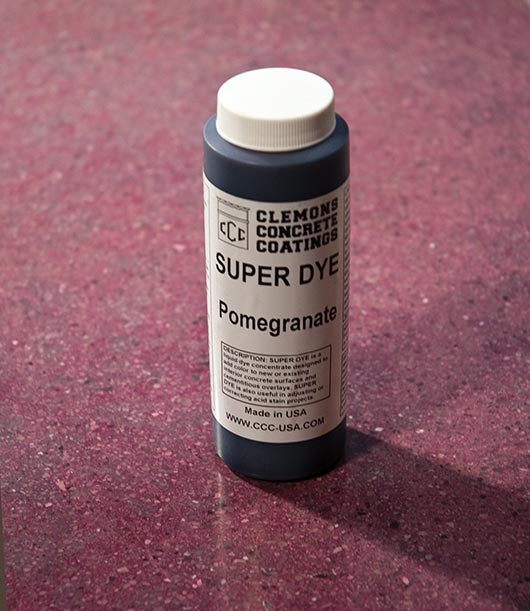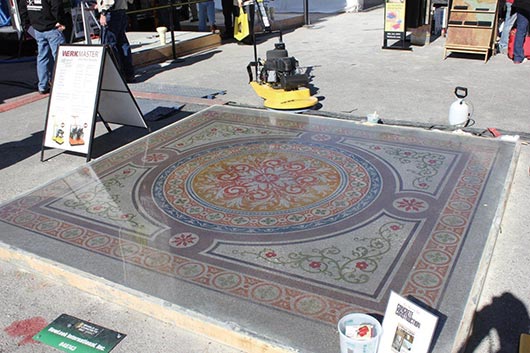Concrete Dye or Stain: Which is Right for Your Job?
Joel Davis
Special Contributor (hover over photos for descriptions)
 Contractors have more options for using color in their work these days with the increasing availability of concrete dyes in addition to the traditional acid-based stains. Which is best for your project? The Slippery Rock Gazette has gone to the experts to find out.
Contractors have more options for using color in their work these days with the increasing availability of concrete dyes in addition to the traditional acid-based stains. Which is best for your project? The Slippery Rock Gazette has gone to the experts to find out.
 In the not-so-old days, acid-based stains were the only option available for coloring concrete.
In the not-so-old days, acid-based stains were the only option available for coloring concrete.
A mixture of water, mineral salts, and acid is applied to the surface and reacts chemically with calcium in the concrete.
 Because of inconsistencies in the surface, acid-based stains give the concrete a marbled or mottled appearance that is unique to each slab.
Because of inconsistencies in the surface, acid-based stains give the concrete a marbled or mottled appearance that is unique to each slab.
 Contractors need to know that Stain– whether it is in an acid, water or other base– is a topical colorant, similar to paint in that it sits on the surface.
Contractors need to know that Stain– whether it is in an acid, water or other base– is a topical colorant, similar to paint in that it sits on the surface.
Dye, on the other hand, is a different story. “Pigments in the dye are absorbed directly into the pores of the concrete, giving much greater color consistency,“ Braxton-Bragg Corporate Trainer Kurt Alexander said. “The acid reaction in stain is not something you can control or regulate. It’s not a controllable situation.
 Dyes are made up of smaller pigment molecules, so they can actually go into and bond inside the pores of the concrete. You can make dye as dense or as diluted as you want.
Dyes are made up of smaller pigment molecules, so they can actually go into and bond inside the pores of the concrete. You can make dye as dense or as diluted as you want.
Also, concrete floors colored with dyed can be polished after the application. The same cannot be said after the use of acid-based stains,“ Alexander explained.
“When I say that stains are topical, that means they sit on top of the surface, and the concrete needs to be properly prepped or opened up to provide a porous surface to give the stain something to bond to. You cannot polish the floor after you apply the stain, but you can apply a sealer to give it a glossy finish.”
Sealer can be applied after both stain and dye is used, Alexander explained. “By using stain and the sealer, you get a very good feel on outdoor projects, because stain is topical. When you seal it, you’ve got a double coat.”
“Dyes are not UV stable and are best for indoor applications,” Alexander said. “A couple of the advantages of using stain is that it has outdoor stability, and it can be sealed.”
Bobby Watson, national sales manager for dye manufacturer Ameripolish Inc., said that dyes provide much more consistent coloring than acid staining. “Acid stains react with the calcium in the concrete. That’s how you get the color. Sometimes, there is no calcium (in sections of the concrete), so there is no chemical reaction, and it doesn’t take. With dyes, you are dying the pores of the concrete so you get more a more even color. With acid stains, you get more of a marbled effect.
“You are not going to run into that with dye because there is no chemical reaction. It’s actually dying the concrete rather than using a chemical reaction to create the color.”
Vancouver, BC-based WerkMaster, manufacturer of award-winning polished concrete and surface preparation equipment, has seen dyes become a larger part of the marketplace, said President Brian Wilson. “Dye is used in a number of scenarios in the marketplace. It gives unique results for customers so that if they choose to dye their floor it will be different from anything that is out there. We see more and more customers looking for color for their floors instead of the standard gray.”
The products have improved over the years. As a result, contractors can use dyes in ever-more intricate applications, Wilson said. “Because the quality of the dyes have improved — especially the water-based dyes — you can be very artistic with what you can do on the floor vis a vis multiple patterns on the floor.”
Customers are asking contractors for more color in their work, Wilson said. “I’ve seen a substantial increase in demand over the last three-to-four years. Now we’re starting to see architects and designers spec color into designs. A number of the chain stores, especially the grocery stores and others like that, are all specking color into their floor systems.”
WerkMaster will be debuting a product related to concrete dye applications at the February 2013 World of Concrete Exhibition, Wilson said. “We’ve been working with dyes over the years,” he said. “It’s not a big part of our business, but it’s an area where we are growing.”
Rich Sanders, general manager of Clemons Concrete Coatings, said that concrete dyes definitely have important advantages over acid-based stains.
“The biggest advantages of dyes… are ease of use and color penetration,” he said. “The ease of use is paramount over acid stains.”
Clemons Super Dye products can be diluted with either water or acetone. The dye is delivered in an 8-ounce concentrated liquid package that installers mix with a gallon of either water or acetone.”
“Ours is a liquid concentrate,” Sanders said. “It mixes immediately in water or acetone for use. That is not common. It is unique.”
Color penetration and vibrance are two selling points for dyes, Sanders said. “Our colors stay more vibrant than any other color on the market through that process. Polishing our dye actually works.”
Clemons Concrete Coatings has been in business since 1953 and entered the concrete dye market about eight years ago, Sanders said. “Because of the ease of use of our dyes, we’re seeing a lot of people switch from acid stains to the dye process. There are more contractors who are getting into polishing. We’re seeing an increase in dye sales because it is almost maintenance-free. It’s as close as you can get with a high quality polished floor.”
Clemons continues to develop products that complement its dye offerings, Sanders said. “What a lot of the polishing contractors are looking for that has been missing has been a good sealer to go with polished concrete. In 2013, we’re coming out with a product called Super Guard that will be a sealer for polished concrete that will resist stains from acidic products such as wine, vinegar, pickle juice, and ketchup.
Acidic things etch the concrete.”
Sanders offers one warning to contractors interested in concrete dyes. “A lot of companies realize that contractors want UV stable dye. The contractor needs to be aware that no dye is UV stable. This is something some companies are getting away with, saying they have UV stable dyes, and that is merely very slick marketing. There is no such thing as a UV stable dye.”
AmeriPolish Inc., an important player in the concrete dyes industry, has its roots in early innovation in concrete dye technology, Watson said. “We were actually contractors at one point doing acid stain and overlays. What we found was that when you do acid-staining sometimes it doesn’t take correctly. We developed a dye to patch that acid stain. Very quickly, we found out we could just use dye and as a company we made a transition into dyes rather than acid staining floors.”
The new dye systems were debuted at the 2006 World of Concrete in Las Vegas. In 2007, company founders Les Davis and Clint Howle formed American Decorative Concrete, which became a leader in concrete color technology with its AmeriPolish and Dye-N Seal Lines. The company later became AmeriPolish Inc. “After we tested it as a contracting company for a year-and-a-half, we developed AmeriPolish and started selling it world-wide,” Watson said. “Eventually, we disconnected from the contracting company.”
An accident led to the discovery that dyes could be use on polished concrete, according to Watson. “At that time there was no way to color polished concrete. We were polishing our shop floor, and… someone kicked over a bucket of dye,” he said. “That was the first time it really got introduced into polished concrete. It did not come out; the color stayed in. That’s when we first figured out we could incorporate the dye with polished concrete.”
Dyes are most suited for indoor applications, Watson said. “With the dyes, there is a limitation because they are not UV stable.”
For more information on AmeriPolish and Clemons Concrete Coatings visit the websites www.ameripolish.com and www.ccc-usa.com .